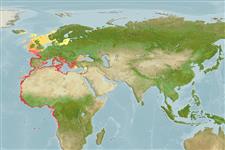>
Carangiformes (Jacks) >
Carangidae (Jacks and pompanos) > Trachinotinae
Etymology: Trachinotus: Greek, trachys, -eia, -ys = rough + Greek,noton = back (Ref. 45335).
More on author: Linnaeus.
Environment: milieu / climate zone / depth range / distribution range
ນິເວດວິທະຍາ
ສັດທະເລ; ນ້ຳກ່ອຍ; ລະດັບຄວາມເລິກ 50 - 200 m (Ref. 27000). Subtropical; 66°N - 13°S, 19°W - 36°E
Eastern Atlantic: Bay of Biscay, British and Scandinavian waters (rare vagrant) to Angola, including the Mediterranean Sea and offshore islands.
ຂະໜາດ / ນ້ຳໜັກ / Age
Maturity: Lm ? range ? - ? cm
Max length : 70.0 cm TL ຕົວຜູ້/ບໍ່ມີເພດ; (Ref. 57392); common length : 35.0 cm NG ຕົວຜູ້/ບໍ່ມີເພດ; (Ref. 26999); ນ້ຳໜັກສູງສຸດທີ່ເຄຍຈັດພີມມາ: 2.8 kg (Ref. 27584)
ຄີ (ໜາມ)ແຂງຢູ່ຫຼັງປາ (ທັງໝົດ): 7; ຄີຫຼັງຂອງປາ (ຄີອ່ອນ) (ທັງໝົດ): 23-27; ຄີ(ໜາມ) ແຂງຢູ່ຄີກົ້ນປາ
ກຸ່ມປາກະດູກແຂງ
ຄວາມຖີ່ຂອງກຸ່ມຖ່າຍທອດພັນ
ປາທີ່ມີການເຄື່ອນຍ້າຍຈາກທະເລໄປຫານ້ຳຈືດ ແລະນ້ຳຈືດຫາທະເລ
ປາທີ່ມີການເຄື່ອນຍ້າຍຈາກທະເລແລະໄປໄຂ່ຢູ່ນ້ຳຈືດ
ຄີກົ້ນຂອງປາ
ສັດທີ່ມີກະດູກສັນຫັຼງ
ການຖ່າຍທອດທາງກຳມະພັນຈາກພໍ່ແມ່ຫາລູກ 3; ຄີກົ້ນຂອງປາ: 22 - 25. Diagnosis: body moderately long (its depth 2.6-3.5 times in fork length) (Ref. 57392, 81654) and compressed (Ref. 57392). Upper jaw very narrow at posterior end and extending only to below anterior third of eye; 22-32 gill rakers on lower limb of first gill arch (Ref. 57392). Tongue with small band of teeth (Ref. 81654). 2 dorsal fins, 1st with 6 spines, 2nd with 1 spine and 23-27 soft rays; anal fin with 2 detached spines followed by 1 spine and 22-25 soft rays (Ref. 57392, 81654). Lobes of soft dorsal and anal fins small (Ref. 57392), dorsal fin lobe 3.9-5.6 times in fork length (Ref. 81654). Length of second dorsal fin base equal to length of anal fin base (Ref. 35388). 2nd dorsal-fin lobe and pectoral fins shorter than head; scales small, cycloid, partially embedded in skin; lateral line very slightly arched over pectoral fins, straight thereafter, and without scutes (Ref. 57392). 3-5 black spots along anterior half of lateral line(Ref. 35388, 57392, 81654).
Coloration: back greenish-grey, sides silvery with 3-5 vertically elongate black spots on anterior half of lateral line; dorsal-, anal- and caudal-fin lobes black-tipped (Ref. 57392).
Adults are moderately common in shallow water in areas of surge. Found in clear waters (Ref. 27584), over sand or mud bottoms (Ref. 27000, 57392). Occasionally enters lagoons and river estuaries (Ref. 57392). Form schools (Ref. 27584, 57392). Small specimens are regularly caught at night from steep rocky shores. Adults feed on small crustaceans, mollusks and fishes (Ref. 4233). Eggs are pelagic (Ref. 4233).
Life cycle and mating behavior
ການຈະເລີນເຕັມໄວ | ການສືບພັນ | ການວາງໄຂ່ | ໄຂ່ | ຄວາມດົກຂອງໄຂ່ປາ | ຕົວອ່ອນ
Smith-Vaniz, W.F., 1986. Carangidae. p. 815-844. In P.J.P. Whitehead, M.-L. Bauchot, J.-C. Hureau, J. Nielsen and E. Tortonese (eds.) Fishes of the north-eastern Atlantic and the Mediterranean. UNESCO, Paris. vol. 2. (Ref. 4233)
IUCN Red List Status (Ref. 130435)
Threat to humans
Harmless
Human uses
ການປະມົງ: ທີ່ເປັນການຄ້າໜ້ອຍ; ການລ້ຽງສັດນ້ຳ: ເປັນສີນຄ້າ; ຊະນິດປາທີ່ຖືກນຳໃຊ້ເຂົ້າໃນການຫາເພື່ອເປັນເກມກິລາ: ແມ່ນ
ຂໍ້ມູນຕື່ມອີກ
ຊື່ສາມັນຄຳສັບຄ້າຍຄືກັນການເຜົາໃໝ້ພະລັງງານໂດຍປ່ຽນທາດອາຫານໃນຮ່າງກາຍໃຫ້ກາຍເປັນຊີ້ນແລະໜັງຜູ້ລ້າການສຶກສາຜົນກະທົບຂອງສານຜິດທີ່ມີຜົນກະທົບຕໍ່ລະບົບນິເວດການສືບພັນການຈະເລີນເຕັມໄວການວາງໄຂ່ການສັງລວມການວາງໄຂ່ຄວາມດົກຂອງໄຂ່ປາໄຂ່Egg development
ເອກະສານອ້າງອີງການລ້ຽງສັດນ້ຳຂໍ້ມູນການລ້ຽງສັດນ້ຳສາຍພັນກຳມະພັນElectrophoresesການຖ່າຍທອດທາງກຳມະພັນຈາກພໍ່ແມ່ຫາລູກພະຍາດການປຸງແຕ່ງNutrientsMass conversion
ເຄື່ອງມື
Special reports
Download XML
ແຫຼ່ງອີນເຕີເນັດ
Estimates based on models
Preferred temperature (Ref.
123201): 9.8 - 17.3, mean 13.9 °C (based on 181 cells).
Phylogenetic diversity index (Ref.
82804): PD
50 = 0.5000 [Uniqueness, from 0.5 = low to 2.0 = high].
Bayesian length-weight: a=0.01072 (0.00688 - 0.01668), b=2.91 (2.78 - 3.04), in cm total length, based on LWR estimates for this species & (Sub)family-body (Ref.
93245).
ຊັ້ນເຂດຮ້ອນ (Ref.
69278): 3.7 ±0.58 se; based on food items.
ຄວາມຢືດຢຸ່ນ (Ref.
120179): ຂະໜາດກາງ, ປະຊາກອນຕຳ່ສຸດທີ່ໃຊ້ເວລາສອງເທົ່າ 1.4 - 4.4 ປີ (Preliminary K or Fecundity.).
Prior r = 0.57, 95% CL = 0.37 - 0.85, Based on 1 stock assessment.
Fishing Vulnerability (Ref.
59153): Moderate to high vulnerability (48 of 100).
Climate Vulnerability (Ref.
125649): Low to moderate vulnerability (33 of 100).
Nutrients (Ref.
124155): Calcium = 70.6 [42.5, 151.8] mg/100g; Iron = 1.64 [0.98, 3.00] mg/100g; Protein = 19.9 [17.9, 22.0] %; Omega3 = 0.444 [0.285, 0.726] g/100g; Selenium = 25.1 [14.2, 43.3] μg/100g; VitaminA = 13.1 [4.3, 35.8] μg/100g; Zinc = 0.739 [0.525, 1.025] mg/100g (wet weight);
